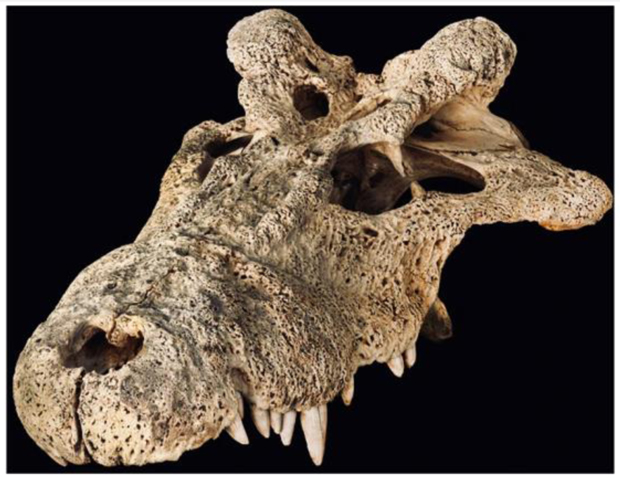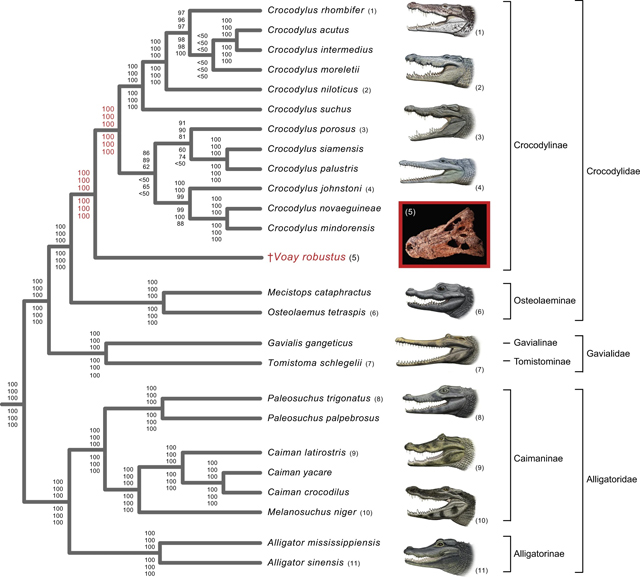Amazing Horned Crocodile Gets a Home
Specimens of a strange, recently extinct crocodile housed at the American Museum of Natural History (New York), have helped unravel a mystery surrounding the evolutionary relationships of crocodilians. The skulls belong to the horned crocodile of Madagascar (Voay robustus) and a research team has demonstrated that it was closely related to “true crocodiles” – Crocodylus, making it the closest species to the common ancestor of the crocodile genus.

Recently Extinct
When the first Europeans came to Madagascar the native Malagasy people told them about two distinct types of crocodiles that lived on their island. There was a gracile form that preferred rivers, this was identified as a population of Nile crocodiles (Crocodylus niloticus), but the swamps and lakes were home to a crocodile that the early explorers had never seen before. This second type was a much more heavy-set and powerful animal with two, bony bumps at the top of its skull.
When first named and described in 1872 (Grandidier and Vaillant), it was thought to be a species of true crocodile – a member of the Crocodylus genus. More recent studies have suggested affinities with the dwarf crocodiles (Osteolaeminae), however, with an estimated length of around 5 metres V. robustus was much larger than any other species assigned to this group.
New research published in the academic journal Communications Biology, which used DNA extracted from the American Museum of Natural History specimens, has resolved the phylogeny of this enigmatic reptile. Carbon dating of the material used in the study confirms that the horned crocodile probably survived until just a few hundred years ago.

One of the authors of the scientific paper, Evon Hekkala, a research associate at the American Museum of Natural History stated:
“This crocodile was hiding out on the island of Madagascar during the time when people were building the pyramids and was probably still there when pirates were getting stranded on the island. They blinked out just before we had the modern genomic tools available to make sense of the relationships of living things. And yet, they were the key to understanding the story of all the crocodiles alive today.”
Mitochondrial DNA extracted from sub-fossil specimens found during a Franco-Anglo-American expedition to south-western Madagascar (1927 to 1930), demonstrates that V. robustus was not a true crocodile but very closely related to that lineage that led to them. Being placed next to the true crocodiles on an evolutionary tree suggests that it was the closest species to the common ancestor of extant members of the Crocodylus genus.

Co-author George Amato, (American Museum of Natural History), explained:
“This is a project we’ve tried to do on and off for many years, but the technology just hadn’t advanced enough, so it always failed. But in time, we had both the computational setup and the paleogenomic protocols that could actually fish out this DNA from the fossil and finally find a home for this species.”
“Teasing apart the relationships of modern crocodiles is really difficult because of the physical similarities,” Hekkala added. “Many people don’t even realise that there are multiple species of crocodiles, and they see them as this animal that’s unchanging through time. But we’ve been trying to get to the bottom of the great diversity that exists among them.”
Surprising Results
The close affinity of Voay to Crocodylus lends weight to the idea that Crocodylus originated in Africa and then dispersed into the Americas and Asia/Australia. Competing theories have proposed an Asian origin for Crocodylus but as Voay was restricted to Madagascar and has been cited as the closest species to the true crocodiles, this DNA analysis lends weight to the “African origins” idea.
The scientific paper: “Paleogenomics illuminates the evolutionary history of the extinct Holocene “horned” crocodile of Madagascar, Voay robustus” by E. Hekkala, J. Gatesy, A. Narechania, R. Meredith, M. Russello, M. L. Aardema, E. Jensen, S. Montanari, C. Brochu, M. Norell and G. Amato published in Communications Biology.
The Everything Dinosaur website: Everything Dinosaur.

